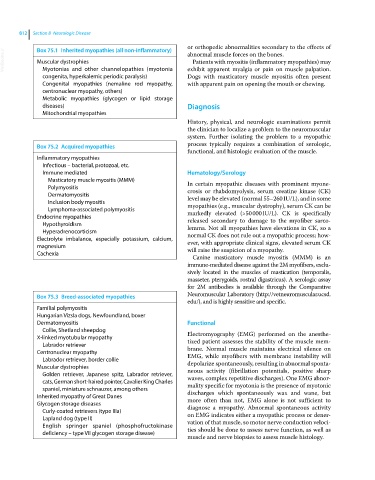Page 844 - Clinical Small Animal Internal Medicine
P. 844
812 Section 8 Neurologic Disease
or orthopedic abnormalities secondary to the effects of
Box 75.1 Inherited myopathies (all non-inflammatory)
VetBooks.ir Muscular dystrophies abnormal muscle forces on the bones.
Patients with myositis (inflammatory myopathies) may
Myotonias and other channelopathies (myotonia
Dogs with masticatory muscle myositis often present
congenita, hyperkalemic periodic paralysis) exhibit apparent myalgia or pain on muscle palpation.
Congenital myopathies (nemaline rod myopathy, with apparent pain on opening the mouth or chewing.
centronuclear myopathy, others)
Metabolic myopathies (glycogen or lipid storage
diseases) Diagnosis
Mitochondrial myopathies
History, physical, and neurologic examinations permit
the clinician to localize a problem to the neuromuscular
system. Further isolating the problem to a myopathic
Box 75.2 Acquired myopathies process typically requires a combination of serologic,
functional, and histologic evaluation of the muscle.
Inflammatory myopathies
Infectious – bacterial, protozoal, etc.
Immune mediated Hematology/Serology
Masticatory muscle myositis (MMM) In certain myopathic diseases with prominent myone-
Polymyositis crosis or rhabdomyolysis, serum creatine kinase (CK)
Dermatomyositis level may be elevated (normal 55–260 IU/L), and in some
Inclusion body myositis myopathies (e.g., muscular dystrophy), serum CK can be
Lymphoma‐associated polymyositis
Endocrine myopathies markedly elevated (>50 000 IU/L). CK is specifically
released secondary to damage to the myofiber sarco-
Hypothyroidism lemma. Not all myopathies have elevations in CK, so a
Hyperadrenocorticism
Electrolyte imbalance, especially potassium, calcium, normal CK does not rule out a myopathic process; how-
ever, with appropriate clinical signs, elevated serum CK
magnesium will raise the suspicion of a myopathy.
Cachexia
Canine masticatory muscle myositis (MMM) is an
immune‐mediated disease against the 2M myofibers, exclu-
sively located in the muscles of mastication (temporalis,
masseter, pterygoids, rostral digastricus). A serologic assay
for 2M antibodies is available through the Comparative
Box 75.3 Breed‐associated myopathies Neuromuscular Laboratory (http://vetneuromuscular.ucsd.
edu/), and is highly sensitive and specific.
Familial polymyositis
Hungarian Vizsla dogs, Newfoundland, boxer
Dermatomyositis Functional
Collie, Shetland sheepdog
X‐linked myotubular myopathy Electromyography (EMG) performed on the anesthe-
Labrador retriever tized patient assesses the stability of the muscle mem-
Centronuclear myopathy brane. Normal muscle maintains electrical silence on
Labrador retriever, border collie EMG, while myofibers with membrane instability will
Muscular dystrophies depolarize spontaneously, resulting in abnormal sponta-
Golden retriever, Japanese spitz, Labrador retriever, neous activity (fibrillation potentials, positive sharp
cats, German short‐haired pointer, Cavalier King Charles waves, complex repetitive discharges). One EMG abnor-
spaniel, miniature schnauzer, among others mality specific for myotonia is the presence of myotonic
Inherited myopathy of Great Danes discharges which spontaneously wax and wane, but
Glycogen storage diseases more often than not, EMG alone is not sufficient to
Curly‐coated retrievers (type IIIa) diagnose a myopathy. Abnormal spontaneous activity
Lapland dog (type II) on EMG indicates either a myopathic process or dener-
English springer spaniel (phosphofructokinase vation of that muscle, so motor nerve conduction veloci-
deficiency – type VII glycogen storage disease) ties should be done to assess nerve function, as well as
muscle and nerve biopsies to assess muscle histology.

